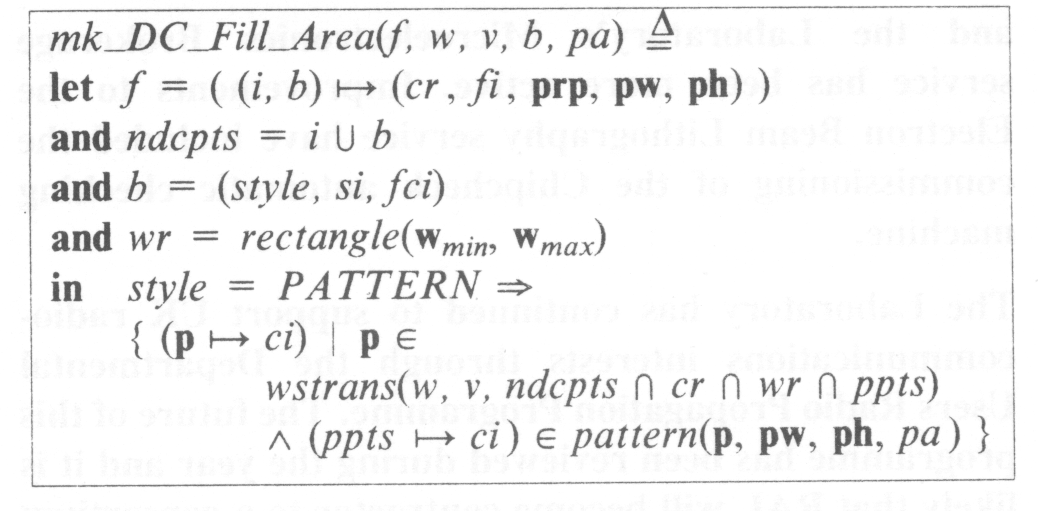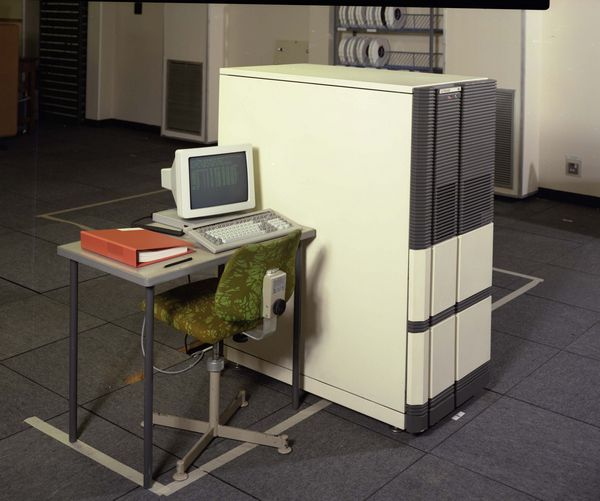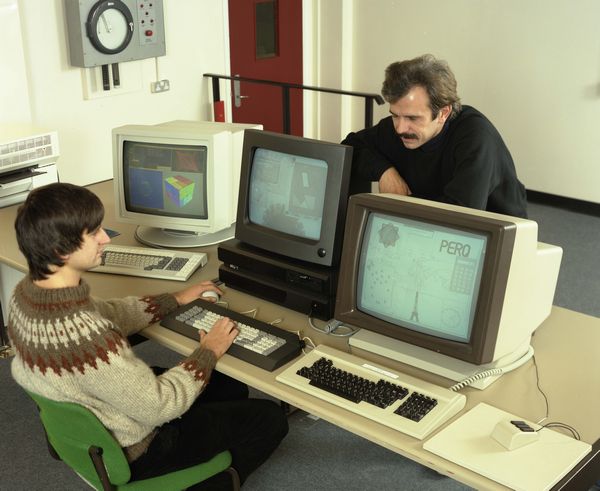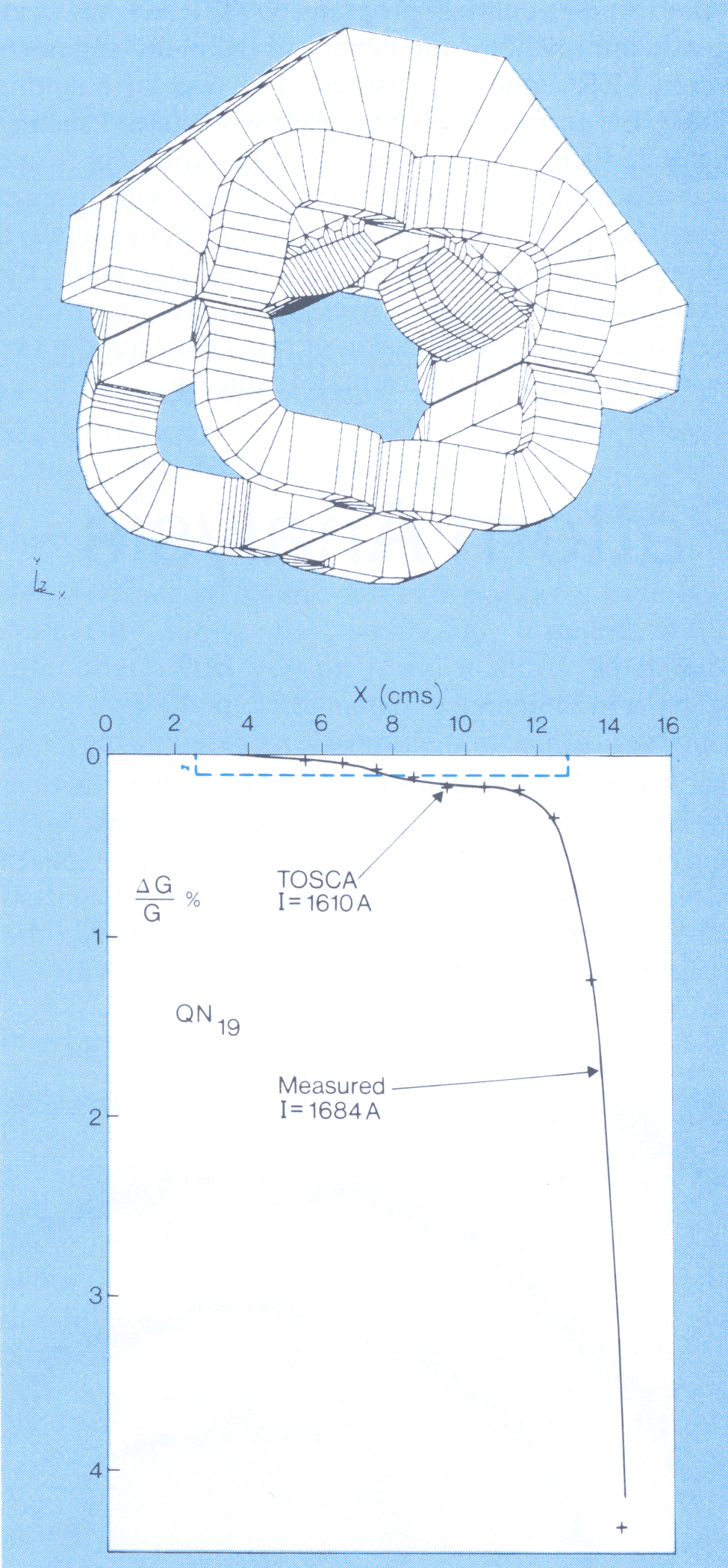

The Engineering Board programme at the Laboratory has, as in previous years, been dominated by work in support of the Information Engineering Committee and the Information Technology Directorate. The Laboratory has been heavily involved in the national Alvey programme in Advanced Information Technology. During the year, 11 collaborative R & D projects have been announced involving the Laboratory in all the underlying technology areas covered by the Alvey programme. The Laboratory has wide responsibilities in the Alvey programme for supporting and managing its computing network infrastructure and organising and coordinating its research programmes in Software Engineering, Intelligent Knowledge-Based Systems and Man-Machine Interface. By the end of the year, 60 people were involved in Alvey-related activities.
There has been steady improvement in the services offered to university micro-electronics designers. The Computer-Aided Design software has been updated and the Laboratory's Microelectronics Brokerage service has been more active. Improvements to the Electron Beam Lithography service have included the commissioning of the Chipcheck automatic checking machine.
The Laboratory has continued to support UK radiocommunications interests through the Departmental Users Radio Propagation Programme. The future of this programme has been reviewed during the year and it is likely that RAL will become contractor to a consortium of Government departments and other interested agencies.
There has been growing interest in industrial exploitation of engineering R & D and a number of licensing agreements have been concluded during the year. A notable example of this has been the successful transfer of the Ocean Surface Current Radar to a UK company and its subsequent use in commercial survey work.
The Alvey programme was launched to mobilise UK technical strengths in Information Technology in order to improve the UK competitive position in world markets. It is a pre-competitive research programme between Government, Industry and academe. The programme is managed by the Alvey Directorate in London and consists of four enabling technologies, Very-large-Scale Integration (VLSI), Software Engineering (SE), Intelligent Knowledge-Based Systems (IKBS) and the Man-Machine Interface (MMI). Directors and their staff coordinate the activities in each area. To provide computing facilities for SE, IKBS and MML an Alvey software/hardware infrastructure has been assembled consisting of multi-user and single-user systems networked with standard software and RAL is concerned with coordination and support. Regular mailshots of trip reports, news, announcements and research reports are made to the community in each area. Workshops, coordination of research activities, advice on grant proposals all help keep the community informed of major activities within and outside the programme. Other Alvey activities at RAL are referred to below, under the headings Pattern Recognition (MMI), and Semiconductor Modelling and Lithography (VLSI).
These software tools aid the process of proving theorems and a major activity this year has been the mounting of a number of theorem prover systems for the user community. In this context, the concern is primarily with proving theorems about programs (for example, that a particular program possesses a particular property). Three current systems, ML/LCF, IOTA and Boyer-Moore have been acquired. ML/LCF was mounted on a VAX and the Atlas 10 under UTS. IOTA is a modular programming system built in Japan which includes a significant verification capability. As IOTA is written in an ancient dialect of LISP, a significant amount of work has had to be done and is still needed before it can be made generally available. RAL is the UK distribution agent for the Boyer-Moore theorem prover.
Alvey and SERC grants have been awarded for work on various aspects of the formal specification of computer graphics systems. As graphical input and output are only approximations to what is defined, proving properties of graphical systems is considerably more difficult than for conventional systems. Parts of the Graphical Kernel System (GKS) standard have been taken and expressed in formal terms (Fig 2.1) and assertions in the standards document have been rigorously analysed. The work has been done in close conjunction with ISO standards activities and has made significant improvements to the formal wording of the standard.

Recognising the UK lead in Logic Programming, a major activity has been the creation of a special initiative with a series of workshops aimed at creating a single balanced programme of relevant research projects. On the software side, contracts have been placed at Edinburgh University to develop NIP, a portable Prolog compiler which can be optimised for specific systems, and at Sussex University to make POPLOG (a combined LISP/PROLOG/POP-II environment) generally available. A research project has started in association with the Alvey IKBS Community Finance Club (Alfex). The Club is producing an Expert System for use in the financial sector and the RAL work will use the 'Knowledge Base' which the Club is producing for research into the segmentation of knowledge. This is in order to investigate the extent to which Knowledge in Expert Systems can be made easier to maintain, modify or use for different purposes.
A major event was the international Workshop on Window Management in April which recommended a series of activities for the near future and longer-term research themes. RAL is coordinating the activities of a number of UK manufacturers to produce a standard application interface to window managers. Work has also started in defining a standard window manager which could work in a variety of environments.
UNISON is one of two high-speed networking projects funded as part of the Alvey Programme. It is a sequel to the UNIVERSE project which ended in September 1984. The UNISON collaborators currently comprise Acorn Computers Ltd, University of Cambridge Computer Laboratory, Logica UK Ltd, Loughborough University of Technology, and RAL. Generally, the objectives of the project are to investigate the provision of an integrated services high-speed digital network suitable for use in the interconnection of the next generation of information technology products. Considerable emphasis is being placed on developing a basic network service and higher level value-added services within a unified architecture, capable of supplying integrated voice, image, and more conventional distributed computing services. The research elements of the project are concentrated in two areas, novel methods for constructing the network services over the Integrated Services Digital Network (ISDN) and investigations into particular advanced applications, of interest in their own right and for test use of the network. An important decision was to base the whole network design upon use of the emerging international standards for ISDNs. An incipient version of this will be provided for the project by the Alvey High-Speed Network, itself based upon 2 Mbps terrestrial links to be supplied by British Telecom and Mercury. This basic network will provide configurable circuit switched high speed links between the participating sites. Project funding was approved during the latter part of the year. The major activities since then have been in specifying the network architecture and initiating the development of specific pieces of hardware needed to interface British Telecom's Megastream to the Cambridge Fast Ring. Preliminary work on the software systems which will be used to provide the common infrastructure for the project has begun and the installation of Megastream links to participants' sites is progressing.
The multi-user interactive facilities supported for Alvey consist of 11 GEC Series 63 systems and 5 Systime 8750s (VAX 11/750 equivalents) with a UNIX service (UTS) on the IBM-compatible Atlas 10 mainframe. Support for the Series 63 systems is provided by Edinburgh Regional Computing Centre under contract, while the V AX systems and the UTS service are supported by RAL using local development systems. The infrastructure also supports SUN single-user systems (see Single-User Systems below).
The major activity this year has been establishing a UNIX service on the Series 63 systems. The standard AT&T System V version of UNIX is now installed on all systems. The connection to the wide area network was initially based on the York box front-end but upgrades from 63/30s to 63/40s have greatly improved the network access to these machines.
The VAX systems are provided to allow import to and export from the Series 63 systems of software required or produced by the user base. In addition, the VAX systems provide a UNIX service based on the Berkeley 4.2 version. The intention is to move to System V UNIX when the version on the V AX stabilises and is fully supported.
During the year, the UNIX service UTS on the Atlas 10 has been established and very encouraging results have been obtained in running large programs on the system. PROLOG, FRANZLISP and ML/LCF have all been mounted. Cambridge University has run in a few minutes on the Atlas 10 proofs written in ML/LCF which would have taken all night on a V AX. The 4250 erosion printer has been used extensively from UNIX utilities such as Ditroff and Pic to produce slides, technical reports and books. The combination of UNIX with the power and peripherals of an IBM mainframe service provides a facility unique in the UK.
RAL supports the Board's computing community via the Single-User Systems programme and the Interactive Computing Facility (ICF). Both are funded through the Board's Computing Facilities Committee. The ICF service continues to be based on PRIME and GEC 4000 systems distributed around the country. Support is provided for 12 PRIME systems and six GEC 4000 systems in universities and polytechnics. In addition, nine PRIME and GEC systems are supported at RAL.
Support for the GEC 4000 systems is to cease. A new version of the operating system (4.15) is in preparation, for release in mid-1986. Systems at Cranfield and Bradford closed during the year and parts of these systems were used to enhance other systems.
All PRIME systems have been upgraded during the year with additional memory, disk capacity and processor upgrades. As a result, 40% power and 20% disk space has been added to the facility. The current plan is to continue running the PRIME system for at least the next five years with a move to running the PRIME UNIX operating system (PRIMIX) alongside the PRIMOS operating system. Benchmarking of the Beta test version of PRIMIX has taken place in conjunction with Surrey University. The major addition to PRIME software this year has been the mounting of the RAL/ICL portable GKS in conjunction with Salford University. The service continues to receive good support from site managers who provide some systems development effort as well as managing the local facility. In addition, the contract with UMIST provides a large part of the PRIME support.
A Pyramid Reduced Instruction Set Computer (RISC) has been purchased as a multi-user system running System V and Berkeley 4.2 UNIX together. This is being used to move existing packages from the PRIME systems in order to assess the performance of such packages under a comparable UNIX system and to ascertain how such packages are restructured to use UNIX facilities. A joint activity with Pyramid will replace the X25 connection currently based on the York box by an in-board solution based on an X25 board.

This year saw the closure of the ICF DEC10 KL at Edinburgh. Over the nine-year life of the installation, it was the major ICF facility providing an excellent service for, in particular, Artificial Intelligence and Computer-Aided Design workers, and the Science Board's Crystal Structure Search and Retrieval Database. The DEC10 system delivered a total of 75,000 Allocation Units to interactive users (about 375,000 terminal connect hours). In a typical year, the machine supported some 60 to 70 SERC grants, corresponding to between 350 and 400 active users. Over the last two years, existing users of the DEC10 have moved to other facilities. One of the last groups to move was the ABACUS design group at Strathclyde University. This group was one of the largest user groups on the DEC10, accounting for some 15 to 20% of machine usage, and has been provided with a Systime 8750 running UNIX, the first external UNIX facility supported by ICF.
The Single-User System programme continues to provide support for high-powered workstations with an agreed set of Common Base software centrally supported. This includes FORTRAN 77 and PASCAL compilers, and NAG and GKS libraries running on top of the UNIX operating system. Wide Area Network communication is provided by the JNT Coloured Book protocols for mail, file transfer and remote log-in.
The original hardware in the Common Base was the ICL PERQ1 machine, of which about 130 systems were installed. This was followed by an architecturally similar system, the PERQ2. Much time during the year was spent assessing various systems in an attempt to find an alternative to add to the Common Base. About 120 manufacturers were contacted initially, ten being selected as able to supply equipment of the correct power. These suppliers received a more detailed Operational Requirement and Apollo, SUN and Whitechapel were chosen for further assessment. Systems were installed and quantitative and qualitative tests were carried out, including the porting of some large applications programs. After detailed assessment of these systems, it was decided to add the SUN2 system to the Common Base. About 50 PERQ2 and 50 SUN2 second-generation systems have been installed (Plate IX). SUN has recently introduced the SUN3 and ICL is due to release the PERQ3. Major activities this year have been a final upgrade of the PERQ Is with a larger writable control store to run the most recent version of the operating system.

Local Area Network communications on the PERQ 1 have been provided by the Cambridge Ring running the Basic Block protocol. These have been less than satisfactory owing to the General Purpose Interface Bus on the PERQ 1 allowing only low speed communications. With the introduction of the PERQ2 and SUN2, the preferred local area network technology is Ethernet. Currently, the SUN2 systems run proprietary protocols (TCP/IP) on the Ethernet hardware while the PERQ2 systems run standard ISO protocols. Work is proceeding to integrate the two systems to allow interworking.
The ICL PERQ2 has a complete range of Common Base software available and a major activity has been to ensure it was available on the SUN2. The major omission was GKS and an assessment of the GKS system provided by SUN is under way. The Spy screen editor developed by RAL has been ported to the SUN2 so that users have the same editing environment on both systems. In addition, a set of utilities forming a graphical toolkit has been developed for the PERQ2 and is being implemented on the SUN2. These provide portable standard ways of accessing input from the mouse, performing raster operations, using pop-up menus etc. Interfaces to these utilities have been provided for FORTRAN, PASCAL and C. A number of software contracts have been let to universities to augment the basic software on the PERQ2. The University of Kent has completed a set of FORTRAN utilities including a source level debugger and an implementation of the NAG TOOLPACK, which provides facilities for documenting and tuning FORTRAN programs. Other work includes on-line documentation and specialist window environments. A contract with Edinburgh University has nearly completed a LISP implementation on the PERQ2.
RAL provides a wide range of computer software to aid the engineering research community in design. The main areas covered are finite element analysis, electromagnetic fields, semiconductor modelling and tools for interactive programs. The underlying theme of this programme is the use of computational modelling techniques to enable research workers to be more productive in engineering design. This has led to the provision of state-of-the-art interactive software systems.
The finite element technique is used as a tool for engineering design calculations and is also an active research subject. There are three main ways in which the Laboratory provides software for finite element analysis: firstly, by the development of specific packages, such as the "Total Scalar Potential' package (TOSCA) for 3-D field problems, secondly, by the support and development of the Numerical Algorithms Group (NAG)/SERC Finite Element Library and, thirdly, by the purchase and support of commercial systems such as the NASA Stress Analysis package, NASTRAN. Standard commercial finite element packages provide most of the analyses required in engineering design including the areas of stress analysis and heat flow calculations. A review of the stress analysis packages is in progress so that SERC capabilities in this area are suitable for the research community but there arc many calculations which cannot be performed by package systems. It is in these areas where the Finite Element Library (FELIB) has been found most useful. Currently, FELIB is being used for electromagnetic and semiconductor modelling, building design, machine tool design and fluid flow calculations. These developments have produced new software which is being included in subsequent releases in FELIB.
The Laboratory is forming a team to develop better algorithms and software systems for the analysis and design of sub-micron semiconductor devices. The work is being funded under the EEC initiative in microelectronic technology and the Alvey VLSI programme. RAL is the prime contractor of the EEC collaboration and is a partner in Alvey programmes in semiconductor process and device simulation. The main aim of the EEC project is to develop more efficient and robust methods of modelling the behaviour of micron and sub-micron semiconductor devices. It is intended that these techniques will reduce dramatically the cost of such calculations. As part of this programme. the Laboratory is leading a software project to produce a new device simulator using the algorithms developed by the other partners. As part of the Alvey programme in VLSI applications. RAL is a partner in modelling the fabrication processes of semiconductor devices and in the validation of device simulators. As a major part of these closely related programmes. the partners are to develop an integrated semiconductor modelling system to simulate device fabrication and behaviour. The Laboratory has the important role of designing and implementing the software which will include a common device/process modelling data base. At RAL, a prototype two-dimensional device simulator has been written using many of the advanced techniques of adaptive mesh generation and refinement developed in its collaborative projects. This research code is now being rewritten to provide a robust design too] for the research community.
The RAL electromagnetics packages have been updated and the solver programs now run in the IBM MVS system. The transient eddy current solver for the two-dimensional PE2D code has been greatly improved. Infinite boundaries and also anisotropic permeable materials may now be represented using the TOSCA program. An example of the use of TOSCA to predict magnetic quadrupole gradients is given in Fig 2.2. Testing the 3-D eddy current package CARMEN has continued. Comparison has been made with measurements using a benchmark experiment at the University of Bath and with results from programs which use different algorithms. Indications are that. for simple cases, the program gives reliable results. Other benchmark tests will be made and compared with results from the FELIX experimental rig at Argonne National Laboratory, USA. Further development is in hand to allow modelling of multiply-connected surfaces and also for transient and non-linear problems to be solved. Further basic research in solving 3-D time-dependent fields has been undertaken by the Laboratory in collaboration with Imperial College, London and the University of Bath.

In January, the Laboratory began active work as a partner in a further ESPRIT project on CAD Interfaces. The project, involving ten industrial and academic organisations from Belgium, Denmark, France, West Germany and the UK, is concerned with the development of software interfaces between CAD programs, finite clement pre-processing, finite element analysers and experimental dynamic analysis results. Effort at RAL in collaboration with the Belgian, Danish and German partners, has been directed towards the design of neutral file structures which will allow the transmission of CAD and finite clement data between different organisations and their computer hardware and software. A MEDUSA CAD workstation has been set up for use with this project and, with a modest amount of programming. a simple and convenient method has been devised for transferring complete engineering drawings to CERN making use of the Hewlett-Packard Graphics Language. The facility could be extended to any organisation with access to a suitable pen plotter. The interface between the pre-processor FEMGEN and the finite clement analysis program NASTRAN has been greatly improved for the benefit of the many engineers within SERC and universities. The task of adapting FEMGEN to run on a single-user workstation such as the ICL PERQ has commenced. In future, pre- and post-processing of finite element models will, in most cases, be performed on such workstations, analysis taking place on mainframe computers with the necessary data transfer over local area networks. Research into the subdivision of tasks between the two types of machine will be a major concern.